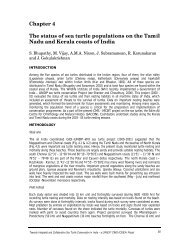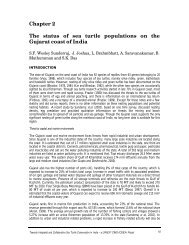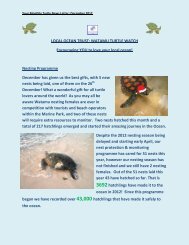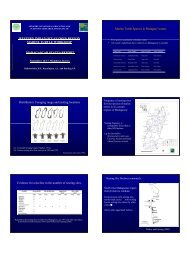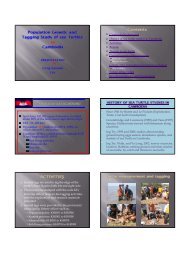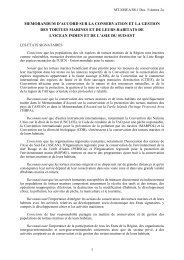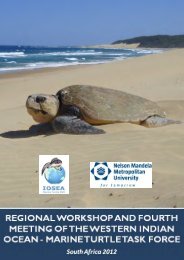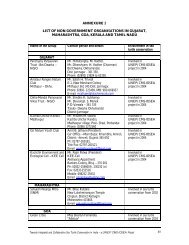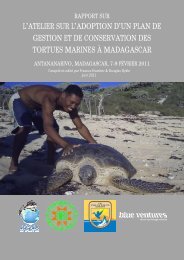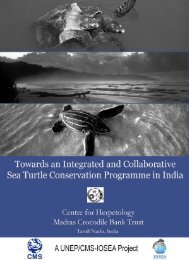Marine Turtle status Report - Indian Ocean - South-East Asian ...
Marine Turtle status Report - Indian Ocean - South-East Asian ...
Marine Turtle status Report - Indian Ocean - South-East Asian ...
You also want an ePaper? Increase the reach of your titles
YUMPU automatically turns print PDFs into web optimized ePapers that Google loves.
and Cherating (Pahang), Pantai Remis (Perak), and Sipadan Island Park (Sabah)(Basintal, 2001; Chan, 2006).The Hawksbill turtle has only two remaining important nesting populations inMalaysia; in Sabah’s <strong>Turtle</strong> Islands Park (primarily Gulisan Island) and in thestate of Melaka in Peninsular Malaysia. Others include Terengganu and Johor(Basintal, 2001; Chan, 2006).The nesting <strong>status</strong> of the Olive Ridley turtle is fragmentary with isolated nestingsreported in Sarawak <strong>Turtle</strong> Islands, Penang, Terengganu, Johor and Kelantan(Basintal, 2001; Chan, 2006).In Sabah, four species of marine turtles occur within its waters and beaches. Ofthe four, the Green and Hawksbill are nesters while the Olive Ridley andLeatherback are only known to forage in Sabah waters (Pilcher et al., 2008).According to Palaniappan (2001), Green, Hawksbill and Olive Ridley turtles areknown to nest sporadically along the beaches and islands on both the coasts ofSabah.The important nesting sites for Green and Hawksbill turtles are the Sabah <strong>Turtle</strong>Islands Park and Sugud Islands <strong>Marine</strong> Conservation Area (Tegaipil, Lankayanand Bilean islands) (Basintal, 2001; Basintal 2002). In April 1997, a historicbilateral agreement between the governments of Malaysia and the Philippinescreated the <strong>Turtle</strong> Islands Heritage Protected Area (TIHPA) -- making it theworld’s first and only trans-frontier protected area for marine turtles, wheremanagement responsibility of the area is shared by the two countries (Basintal,2001). TIHPA and Berau Islands in Indonesia form the largest aggregation ofnesting Green turtles in <strong>South</strong>east <strong>Asian</strong> region, and as one of nine remainingmajor nesting habitats for Green turtles in the world (Limpus, 1994a).Sipadan Island Park was also identified as an important turtle rookery for Greenturtles in Sabah (Mortimer, 1991; Irwan, 2008). According to Palaniappan(2001), Sipadan Island Park supports a large density of nesting Green turtles,second only to the Sabah <strong>Turtle</strong> Islands Park. Occasional nesting occurred in theTun Sakaran <strong>Marine</strong> Park, specifically at Mantabuan Island (Wood, 2001). Otherreported nesting islands or beaches for Green turtles include Kg. Hujung on theeastern part of Jambongan Island (Suliansa et al., 1997 as cited by Basintal,2001), Koyan-Koyan, and Nunu-Nunukan (de Silva, 1969 as cited in Basintal,2001).Gulisan Island of Sabah <strong>Turtle</strong> Islands Park provides nesting habitat to thelargest Hawksbill turtle population in the entire <strong>South</strong>east <strong>Asian</strong> region (Limpus,1994a, Chan et al., 1999). Other sites include Lankayan Island (SIMCA),Jambongan Island, and Tanjung Puru-Puru close to Kaniogan Island (Suliansa etal., 1997 as cited in Basintal, 2001). Some Hawksbill nesting also occurred inSipadan Island Park in lesser numbers (UKM, 1990 as cited in WWF-Malaysia,6



